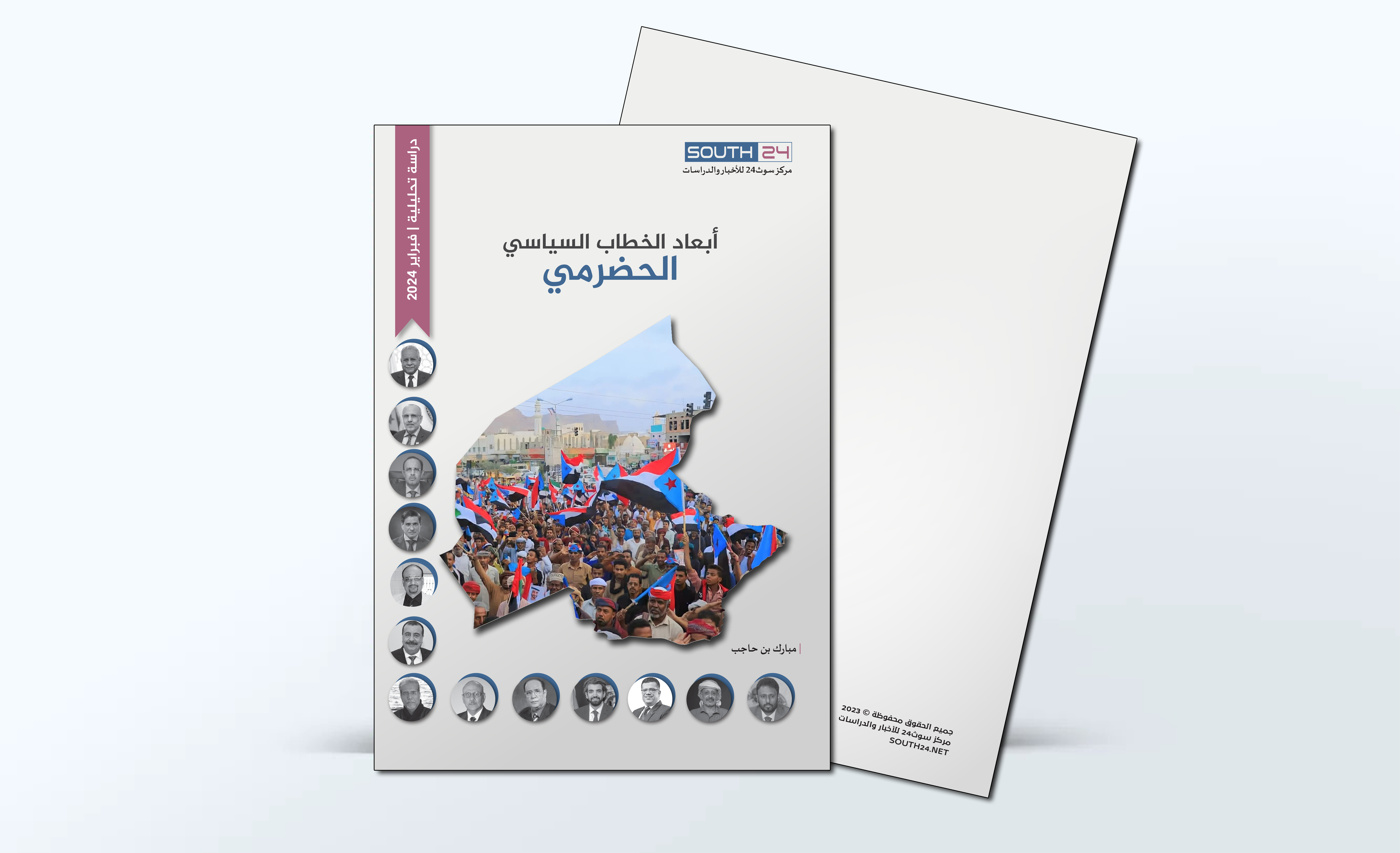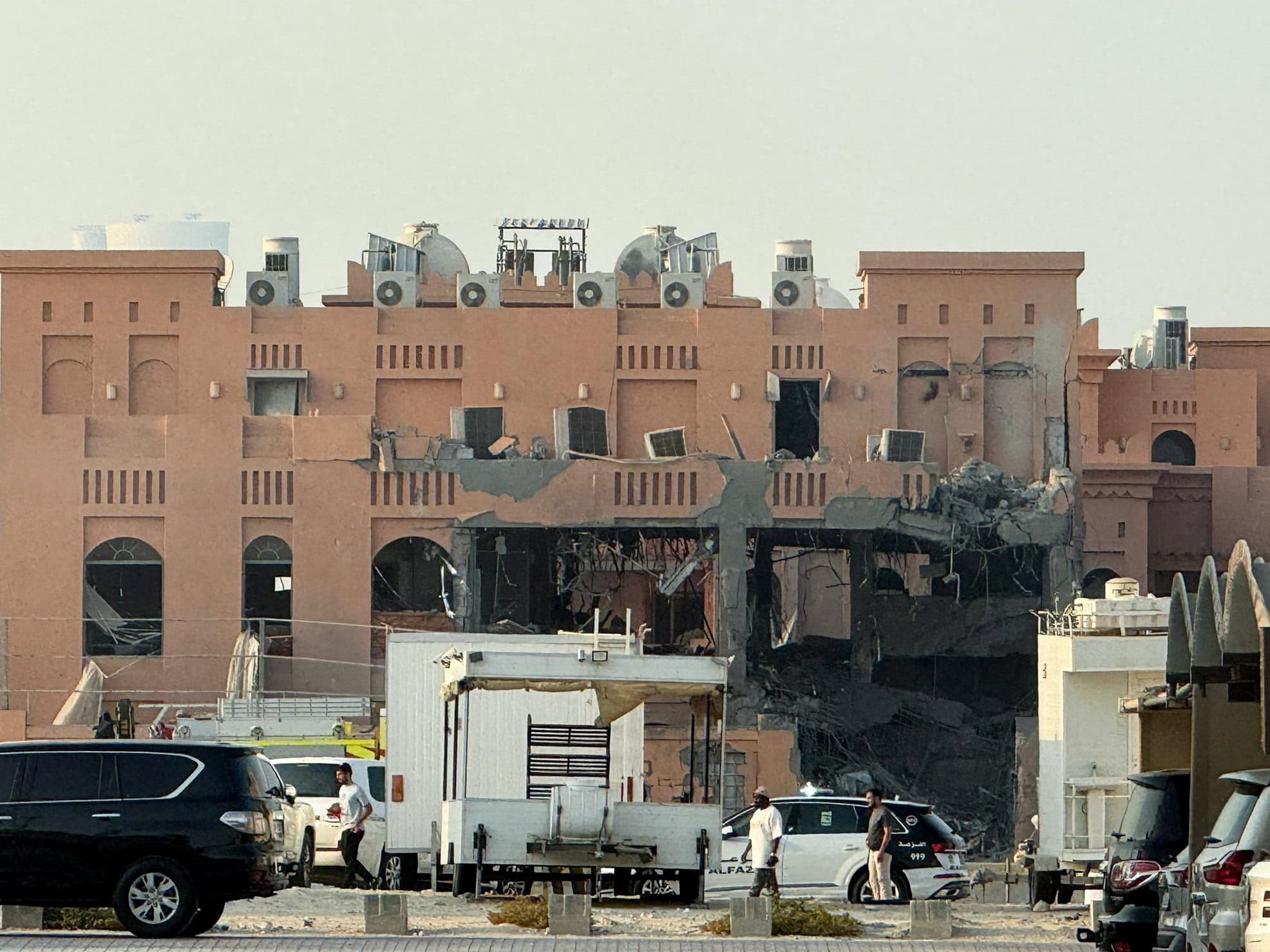
Study cover: South24 Center
آخر تحديث في: 28-02-2024 الساعة 8 صباحاً بتوقيت عدن
The study aims to explore and understand the dimensions of the modern political discourse of Hadrami figures and entities, including political and tribal groups. It draws an illustrative map for the realization of the political movement in Hadramout.
Mubarak Amer Bin Hajeb (South24)
A new study has called on Hadrami figures as well as political and corporate forces in Hadramout in South Yemen for adopting a political discourse compatible with the inclinations and demands of the Hadrami common people, community entities, and tribal groups to preserve the unity of Hadramout.
The study, issued by ’South24 Center‘ on Saturday (Feb 24) in Arabic, recommends preserving Hadramout for its historical geographical surroundings. It calls for adopting the project for a federal Southern State which is the most realistic and appropriate one for Hadramout compared to other political proposals.
The study, prepared by the Hadrami media discourse expert Mubarak Amer Bin Hajeb, analyzes the political media discourse of Hadrami individuals and entities as well as political, tribal, and community groups. This comes amid the political, military, and economic conflicts experienced by Hadramout over the past years. The study highlights the impact of the state's disintegration1 and the attempt by internal, regional, and international forces to draw the features for a new Yemeni state based on a comprehensive peace process.
According to Bin Mubarak, the study basically aims for a critical analytical comparison between two discourses; the first related to the project of restoring the Southern state, and the second one supports the scheme for a Yemeni federal state. The study also seeks to answer a pivotal question, raised by the author, about the reasons behind promoting the plan for a federal Yemen in Hadramout.
This is considered among the first studies that address the Hadrami peoples’ political discourse. It is an important addition to local and Arab readings interested in the humanitarian performance with all its types to understand the reality of the current political scene in Hadramout.
The study is based on analyzing and critiquing 23 videos from TV and audio interviews that feature Hadrami political, military, and tribal figures in addition to some written reports and opinions in this regard.
The study leads to some important conclusions which demonstrate the dimensions of the Hadrami political discourse with all its different proclivities. Some of them support the idea of restoring the Southern State, while others endorse turning Hadramout into a territory as part of a Yemeni federal state:
● The Hadrami political discourse rides a wave of tribal dimensions in Hadramout. This is through tribal leaders who use the heritage of their tribal entities to produce a media discourse in keeping with their political aims. The latter is probably rejected by the majority of the tribal people in certain cases such as the project for turning Hadramout into a territory.
● The tribal aspect is present in the political and military conflict in line with the internal and regional agendas in Hadramout at the expense of local consensus.
● The regional and individual tribal territorial dimensions and the monopolization of representation of Hadramis by some tribal and community leaders in some important Hadrami entities while rejecting the participation of others are considered a main reason behind their immobility. They were exposed in their political ambitions while spawning similar approaches. This is like what happened with the ‘Inclusive Hadramout Conference’ and the ‘Hadramout Tribes Confederacy’.
● The Hadrami discourse that calls for establishing a Hadrami territory as part of a Yemeni federal state, adopted by the leaders of the ‘Arbitration of the Hadramout Tribes’ and the desert of Hadramout in particular, relies upon the Yemeni partisan influence, especially the Islah Party which enjoys the lion’s share of such clout.
● The clear support submitted by symbols of the Yemeni state, especially the Northern ones, to the scheme to turn Hadramout into a territory blatantly goes beyond the calling of the political and military reality on the ground.
● The Muslim Brotherhood's branch in Hadramout constitutes a political and ideological dimension supporting the aim of turning Hadramout into a territory as part of a future Yemeni federal state. It uses media platforms to distort the image of its rivals in order to pervade the Hadrami local society and widen whatever rifts exist.
● The repeated efforts to launch the project for a Yemeni federal state from Hadramout as part of the outputs of the ‘National Dialogue’ represent an important strategic dimension of it. This is due to the huge economic, cultural, and geographical weight of Hadramout in the Yemeni arena and the Southern one in particular. 2
● Despite the Hadrami discourse that supports the restoration of the Southern state, the Southern Transitional Council (STC) has preferred not to militarily confront the 1st Military District unlike what it did elsewhere. This has constituted a security dimension which encourages the voices supporting turning Hadramout into a territory as part of a Yemeni federal state.
● The outward harmony between some Hadrami forces and the Northern parties is considered a basic dimension that enhances the rejection by Hadrami and tribal entities of the Hadramout National Council's establishment3. The most prominent of which include the ‘Inclusive Hadramout Conference’, the ‘Hadramout Tribes Confederacy’, the ‘Confederacy and the Inclusive Bloc for Hadramout and South’ and other tribal and community gatherings.
● Getting rid of the Yemeni unity project and seeking to restore the Southern State are considered a strategic dimension of the pro-STC Hadrami discourse.
● The Northern forces’ misreading about the concept of Yemeni unity is another reason behind calls for a strong Hadrami dialogue that sides with the campaign for restoration of the Southern State.
● The Hadrami common folk along with the community's institutions and the majority of the Hadrami tribal groups constitute a strong internal dimension that support the dialogue for restoration of the Southern State.
● The STC’s internal and external political approach and its vision toward a federal state constitute an important political dimension of the Hadrami discourse supporting it despite some criticism within the internal path.
● The harmony between Hadramout and South Yemen along with the important Hadrami role in the liberation movement against British colonization and the former Southern state’s administration as well as the fight for the Southern cause represent a basic historical and social dimension for the Hadrami discourse supporting restoring of the Southern State.
● The regional dimension is considered an additional reason for deepening the division within the Hadrami political discourse. This is due to its role in forming political entities which have expanded the rifts in Hadramout. This happened after announcing the establishment of the Hadramout National Council in Riyadh, in the presence of the Saudi Ambassador in Yemen Mohammed Bin Jaber. This has put additional pressure on other Hadrami projects.
Recommendations
The study concluded with some recommendations, the most important of which are:
● All Hadrami political, press, tribal and corporate figures have to adopt a political discourse, in harmony with the inclinations and demands of the Hadrami people, community entities, and tribal groups to maintain the unity of Hadramout.
● The path of the ’Inclusive Hadramout Conference‘,4 which enjoys Hadrami consensus, should be corrected. The Hadrami political entities that represent an extension of external agendas which don’t serve the Hadrami citizens should be renounced.
● The Hadramis must gather around the Hadrami Elite Forces 5 and work to deploy them across the governorates instead of the 1st Military District whose loyalty to Hadramout is questionable. The creation of managed military formations that would threaten the unity of Hadramout in the future should be avoided.
● There is need to adopt a realistic media discourse devoid of individualized desires and territorial wishes. Hadramout governorate’s moderate religious heritage must be preserved, and kept away from ideologies alien to the Hadrami society.
● There is need for preserving Hadramout as part of its historical geographical surroundings and not go along with political ambitions that drag it into internal and regional power centers which go against the Hadrami cultural, political, and religious heritage.
● Adopting the goal for a federal Southern State. This is the most realistic and appropriate for Hadramout compared to other political projects. This would be in addition to enhancing its substantial historical, political, cultural, demographic, and doctrinal linkages with the other Southern governorates to ensure Hadramout does not fall victim to a plethora of deliberate internal and external strategies.

قبل 3 أشهر

قبل 3 أشهر